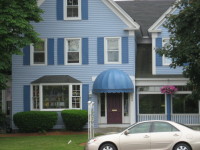Stained Solid Wood Doors
July 23, 2007 § 2 Comments
Many of you, after reading about how garage doors are painted the house color and how front doors should be a stand-out color, have written in about using stained solid wood doors. My comment to that is, whenever your budget allows for solid wood doors, go for it. There’s nothing like the richness of wood, whether it’s a mahogany stained front door or garage doors, to dress up your home.
Avoiding the Clash of Colors
July 19, 2007 § 66 Comments
Every day I drive by this office building, a big brick square structure along a main road. And every day I wince when I see the annual flowers in the huge bed along the driveway. The brick building is, well, brick. It has rusts and browns and taupes and rusty reds and all earth tones. Not anywhere do I see raspberry pink. Call me neurotic about color, but with all the other choices of annuals — red, yellow, orange, purple, blue, cream, and white — they chose to plant a huge bed of hot pink flowers in front of a rusty red brick building. Sorry, but yuck.
It’s nice to consider the color of your home or building when decorating with plants and flowers. You can really enhance the curb appeal by landscaping with colors that coordinate with or compliment the building or house color. At least try to avoid colors that clash.
For that brick building, I would have planted either a big bed of cream and white flowers to add a little life to the dark brick or a bed of purple and blue flowers to give the space a little punch. As the complimentary colors to the orangey brick, the purply blues would make both building and garden look terrific.
Cottage Colors: Back from the Lake
July 5, 2007 § 17 Comments
 My apologies to anyone who surfed over this way only to find empty posts and no comments for two weeks. I’ve been at my dad’s cottage away from all civilization (including my trusty computer) for two weeks. Although it was restful, the pile of emails and assorted communications that went unanswered is daunting. But I’m back.
My apologies to anyone who surfed over this way only to find empty posts and no comments for two weeks. I’ve been at my dad’s cottage away from all civilization (including my trusty computer) for two weeks. Although it was restful, the pile of emails and assorted communications that went unanswered is daunting. But I’m back.
While I was there, Dad decided to have the outside of the cottage painted. Or at least talk about it. And I had left all my color wheels at home. Why would I need them, I reasoned. Well, boy was I lost without them. I took a jaunt to the closest Home Depot and stood there in front of all the color swatches, just like many of you have been doing. I too was overwhelmed by the choices. Somehow with my own color wheels from all the various paint companies, I can maneuver through the myriad choices landing on the ones that I know will work. But in front of this maze of marketing displays, it was color overload. I grabbed a handful of paint chips and bolted for the door.
Back at the cottage, the process took shape. We decided on dark green trim for practical reasons. The spider droppings are black and show up on light trim. With a dark color, you don’t have to scrape the black spots off as often. Terrific. (I verified this by wandering over to a neighbor’s cottage that had white trim. Yup. Black spots.) Then we decided to go with a medium green for the body. Again for practical reasons. It will blend with the dark trim and not stand out very much. The surroundings are all green, of course, and the cottage will blend in. Just as Dad wants. Nothing flashy for this cottage. It’s pretty rustic. And the orange daylillies will really look sharp against the green backdrop.
When you’re choosing cottage colors (or colors for any dwelling that’s buried deep in nature’s colors), stick with colors that appear in nature. They don’t have to be greens, but taupes and tans and natural stone colors work great. As do darker blues and browns. Keeping to colors you find in your landscape will leave the vista uninterrupted to the eye. The cottage will look like it belongs right where it is.
Stone and Blond Brick House Trim Colors
June 20, 2007 § 261 Comments
 When you’re dealing with natural materials, I like to stay in the earth tones for trim color. And there’s nothing more striking than a dark wood door on a stone facade. For me, it just conjures up images of castles and old English cottages. Choosing colors that come out of the natural variation in the stone or brick makes the most sense to me. Yes, we’re talking creams, taupes, and tans. But depending on the tones in your stone or blond brick, you could lean in the clay red direction or chocolate brown.
When you’re dealing with natural materials, I like to stay in the earth tones for trim color. And there’s nothing more striking than a dark wood door on a stone facade. For me, it just conjures up images of castles and old English cottages. Choosing colors that come out of the natural variation in the stone or brick makes the most sense to me. Yes, we’re talking creams, taupes, and tans. But depending on the tones in your stone or blond brick, you could lean in the clay red direction or chocolate brown.
Keeping the house natural may seem blah, but that’s the way the house would look if it were built centuries ago. Don’t ignore the roof color though, and if you’re choosing a roof for a stone or brick house, I would avoid a lot of color variation on the roof. It will look really busy if the roof is not a solid color. Some people like that — but I get migraines.
Keeping Up with the Joneses’ House Colors
June 18, 2007 § 8 Comments
 Businesses need to attract attention and this day spa does so in a good way with a very pleaseing cornflower blue color scheme. Some over-55 communities also have similar colorful palettes for their house colors. The builder chooses the colors, of course, but they all go together nicely. One community in New England I saw advertised in the Boston Globe had very brightly colored homes, from sunflower yellow to peacock blue. That’s terrific.
Businesses need to attract attention and this day spa does so in a good way with a very pleaseing cornflower blue color scheme. Some over-55 communities also have similar colorful palettes for their house colors. The builder chooses the colors, of course, but they all go together nicely. One community in New England I saw advertised in the Boston Globe had very brightly colored homes, from sunflower yellow to peacock blue. That’s terrific.
If you live in a community (particularly new construction where you’re not concerned with historic palettes) in which all your neighbors are painting their houses bright colors, and you’d like to follow suit, go for it. When I mentioned in previous posts that your house should fit into its environment, those brightly colored neighbors’ homes ARE part of that environment.
The problem comes when your neighbors all have traditional home colors, white, grey, khaki green, colonial blue, and we come upon YOUR house in a neon salmon. We all like to march to our own drummers, but sometimes it just doesn’t look good. You get the picture.

